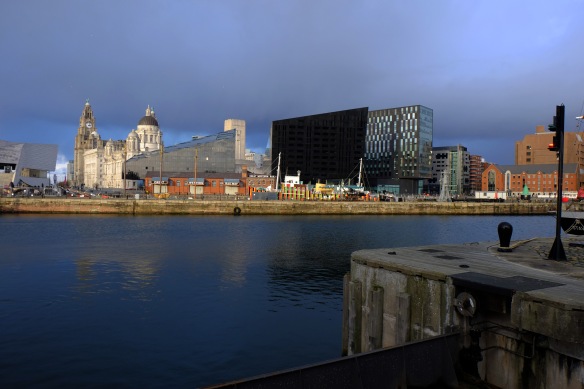I had a recent trip to Tate Liverpool and a wander around the Albert Dock complex. Across the dock you cannot fail to see one particular ship that looks like no other.
In the lead up to the 2014 centenary of WW1, the “1418 NOW” (WW1 Centenary Art Commission), Liverpool Biennial and Tate Liverpool jointly commissioned, in partnership with National Museums Liverpool the artist Carlos Cruz-Diez to work with the idea of ‘dazzle’ camouflage using an historic pilot ship conserved by Merseyside Maritime Museum.
The “Edmund Gardner” is situated in a dry dock adjacent to Liverpool’s Albert Dock development. The ship was unveiled prior to last year’s International Festival for Business which took place at the Liverpool Convention Centre further along the waterfront. Unfortunately you cannot get too close to it at the moment as the area is fenced off whilst they improve and re-surface the area around the dock.
 Dazzle painting was a system for camouflaging ships that was introduced in early 1917, at a time when German submarines were threatening to cut off Britain’s trade and supplies during WW1. The idea was not to “hide” the ships, but to paint them in such a way that their appearance was optically distorted, so that it was difficult for a German submarine to calculate the course the ship was travelling on, and so know from what angle to attack. The “dazzle” was achieved by painting the ship in contrasting stripes and curves that broke up its shape.
Dazzle painting was a system for camouflaging ships that was introduced in early 1917, at a time when German submarines were threatening to cut off Britain’s trade and supplies during WW1. The idea was not to “hide” the ships, but to paint them in such a way that their appearance was optically distorted, so that it was difficult for a German submarine to calculate the course the ship was travelling on, and so know from what angle to attack. The “dazzle” was achieved by painting the ship in contrasting stripes and curves that broke up its shape.
The approach using garish colours and a sharp patchwork design of interlocking shapes was heavily influenced by the artistic movement of Cubism. Dazzle painting was invented by a marine painter, Norman Wilkinson who later became President of the Royal Institute of Painters in Watercolours. He was influenced by avant-garde British painters such as Wyndham Lewis and David Bomberg. The artist Edward Wadsworth supervised the application of ‘dazzle’ patterning to over 2,000 ships and he later made a series of paintings on the subject.
Carlos Cruz-Diez is a famous contemporary artist especially in what is called ‘kinetic-optic art’ with his works to be found in the Museum of Modern Art, New York; Tate Modern, London; Centre Georges Pompidou, Paris; Museum of Fine Arts, Houston; and the Wallraf-Richartz Museum, Cologne.
The close relationship of ‘dazzle’ technology to British art extended right through its manufacture. Each British pattern was unique, and many of the designs were invented by women from the Royal Academy of Arts in London. These were then tested on wooden models, viewed through a periscope in a studio to assess how they would work at sea. The practice of ‘dazzle painting’ ships has largely, but not entirely, fallen out of fashion in the military now.
From my distant vantage point it was difficult to get a clear shot of the ship. But interestingly with the dark rain leaden skies with a late winter afternoon sun shining lowdown casting a golden glow, the ship was actually camouflaged against the dark angular buildings of the Mann Island development on the Strand behind the dock. Certainly compared with the Mersey Bar retired lighthouse ship anchored in next door Canning Dock it has hard to make out the form of a complete ship. I must return once again when I can get a close up view.
The ship will be returned to its original livery in late 2015 and the attention the vessel has received during the project will help fund her long term preservation. But I am told that a design by leading British artist Sir Peter Blake will cover the Mersey Ferry, Snowdrop with a distinctive pattern, as it continues its commuter service as a ‘dazzle ferry’. It is being completed by local ship builders Cammel Laird in their Birkenhead yard and it will be in operation between the Spring 2015 up to the end of 2016.







